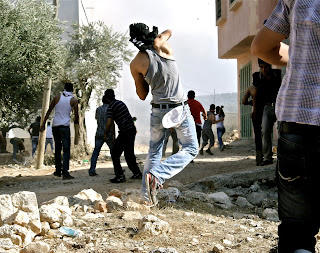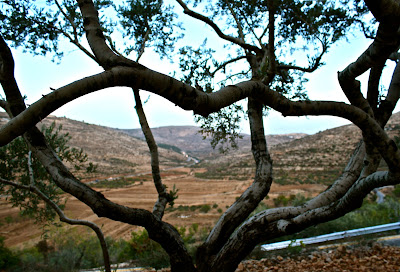On Tuesday, February 12th, 2013, our three person MPT team was invited to the village of Urif to accompany local Palestinian farmers. The farmers had planned to plant 50 olive trees to replace trees that had been previously burned.
 Upon our arrival in Urif we were greeted by the local villagers and invited to meet with the Urif City Council members. We were informed the area we would be entering was located in Area B, land under Palestinian authority. Six additional internationals arrived shortly thereafter to join in the accompaniment.
Upon our arrival in Urif we were greeted by the local villagers and invited to meet with the Urif City Council members. We were informed the area we would be entering was located in Area B, land under Palestinian authority. Six additional internationals arrived shortly thereafter to join in the accompaniment.
After being briefed and sharing a cup of coffee with the local villagers we ascended up a hillside to the edge of the village. We then assisted the villagers in loading olive trees into a bus, and proceeded to follow on foot to the planting field.
When we arrived in the field, we noticed armed Israeli forces already stationed on the hillside above us. As soon as we began to unload the trees from the bus, the soldiers started descending upon the Palestinian land. Despite the military presence, the farmers began planting their olive trees. We decided to take on the role of observation, filming and photographing the events at hand.
Soldiers soon arrived on the scene. One soldier immediately demanded to see our team’s passports. We asked to see the soldier’s identification and he produced his Border Police card. As Julie and Jessica removed their passports from their bags the soldier immediately took them and walked away.
The three of us continued to observe, video, and photograph the scene. The armed soldiers began to use force, pulling the villagers’ tools out of their hands, filling in the holes as they were digging, and kicking over newly planted olive trees. At this point we noticed many soldiers surrounding one older farmer as he was planting a tree. As the farmer knelt on the ground, the soldiers began grabbing his arms and body while shouting at him. We quickly came to a team consensus to then interposition ourselves between the soldiers and the farmer.
 |
| Israeli soldiers pulling a local farmers tools from his hands as he plants trees in his field. |
 |
We positioned our bodies between the farmer and the soldiers, creating a circle while helping him to finish planting his tree. The soldiers pulled us away and attempted to arrest the farmer. We then clung to the farmer as members of the Israeli forces pepper sprayed the whole group. In spite of this aggression, we were still successful in de-arresting the farmer and he was able to leave.
In Ari’el the Israeli soldiers produced documents written in Hebrew we refused to sign. Our passports were then given to the local Ari’el police and we were transferred into their custody. The local police photocopied our passports and contacted the American Embassy. During this time we discussed our day’s action. We all felt elated that no Palestinians were arrested. We were happy to have taken the place of a Palestinian farmer, because he would have surely face long imprisonment under harsh conditions.
After four hours of detainment, we were shown an Israeli document claiming that the area we were taken from is a closed military zone. As a condition of our release we signed a paper stating we would not reenter the area. We were then released along with the three other internationals.
We all then walked out of the Israeli settlement, down an illegal Israeli only road built on Palestinian land. We exited the road through a Palestinian field where we were greeted by a shepherd and other locals as we entered the village of Yasuf. In the small village we met a service driver who insisted we come to his home for coffee before driving us home.
Our day had amazing contrast between the warmth we felt from Palestinian villagers and the bitter chill of the Israeli soldiers. We were glad to be among friends once again.
-MPT Winter Team 2013
Julie, Jessica, and John-David























